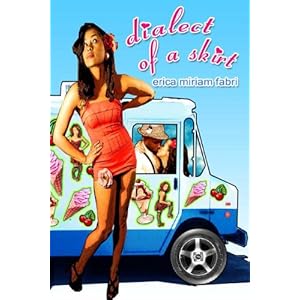REVIEW
Fashionable Poetry: Fabri's Dialect of a Skirt

Dialect of a Skirt by Erica Miriam Fabri
Hanging Loose Press, 2009 (88 pages)
ISBN: 978-1934909102
Hanging Loose Press, 2009 (88 pages)
ISBN: 978-1934909102
Self proclaimed as a "foxy poet," Erica Miriam Fabri combines hints of magical realism, bizarre whimsy, and unapologetic sexuality in her debut collection, Dialect of a Skirt. Fabri divides the book into five sections, each titled after a different item of a woman's wardrobe. The work is concerned with themes of biracial love, reinventing the love poem, and particularly the tangibility of words. Spoken through the voices of unusual characters, the book introduces the reader to a strange world intrinsically seductive and compelling.
The first section "The Pencil Skirt," exposes Fabri's fascination with words as objects, easily manipulated and rearranged. Her metaphors are fresh, unexpected, and spot-on. She places words in a context where they become tangible items, plucked from the air and sewn onto the page. "In Jacklight," her characters experience this tactile nature of language:
What are you doing? He asked, when he felt one finger
and one lip touch his chin: looking for words, she said.
How many have you found so far? he wanted to know,
because he had heard a bag of wooden letters rattle in the dark.
What if the pills you swallow are actually dragonflies, rubbing
the dust from their wings all over your belly? What if
there is an octopus in your backyard? What if there are
firecrackers in your onions?
Fabri explores themes of the power of language to rework human perception, creating depth and attachment to the ordinary. Her images are lush, falling effortless atop one another. She forces readers to perceive a world where pills become dragonflies and onions explode in the mouth like firecrackers. In "When the Muse Comes Home," Fabri chronicles how the poet spends her days "rearranging words" (10) and imagining new ways to "say red."(9) It is this attention to creating new ways of transforming the commonplace that makes her poems sing.
Readers continue to experience the vibrancy of language in unexpected ways in the next section of the book, "The Garter Belt." Here, she introduces specific characters such as Marilyn Monroe and Betsy Johnson. By keeping the majority of the poems in second person, Fabri creates a sense of distance and story within the work, giving it a dark fairy-tale quality. Often she simply uses the ambiguous character of the poet, the fishwife, or the muse to shape her work. As the book progresses, the characters re-emerge in the third section, "The Corset" and again in the fourth, "The Miniskirt." The voices speak of love, of miscarriage, of rape. Fabri gives them full license to speak in honest and graphic brutality. She abandons her stark depictions in the last section, "The Silk Shop," and includes a series of love poems strung together. The final poem "The Animal of Love," depicts a couple in the lull after lovemaking. She concludes the poem with the lines:
I will swim belly-to-belly
with you forever, and if you die first
I will beach myself, because it would be
too lonely to live without your silver flesh.
Once again, Fabri offers up her images as delicacies readers are unable to refuse, pandering her words like a New York street vendor. But something about Fabri is undeniably compelling. Maybe it's her slick use of metaphor, her sassy line breaks, or fiercely feminine perspective. Whatever the case, Fabri's work stands as a stunning first achievement and a fresh voice in poetry.
Joy Sullivan is currently pursuing an MA in Poetry at Miami University in Oxford Ohio.
